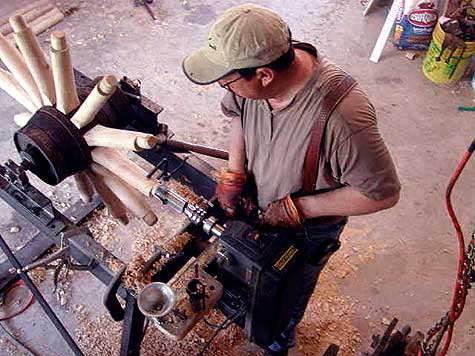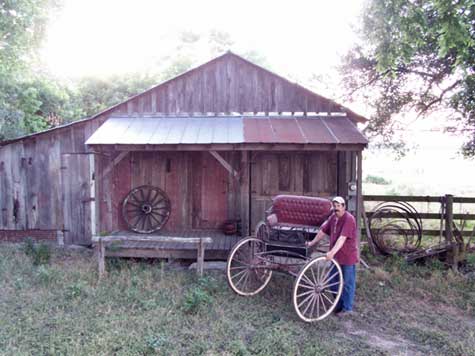 Jack Laborde, a Rex member who was on hand, remembers Shelton's terse summary of the situation: "You've got problems." Jack Laborde, a Rex member who was on hand, remembers Shelton's terse summary of the situation: "You've got problems."
But with just a few months to go before the 2006 parade, there wasn't enough time to do the extensive repairs -- and, in some cases, rebuilding -- that the wheels needed, Shelton said.
Working like a combat medic, Shelton picked the 10 wheels that were in the worst shape and did stopgap work, such as tightening spokes, to get them through last year's parade.
A huge task
After last Fat Tuesday, Shelton, who lives and plies his trade about 60 miles from San Antonio, had the time to do the work he loves. He repaired five of the 150-pound wheels and made 14 others from scratch.
"It's one of the biggest jobs I've ever done," he said in a telephone interview. "We had to build equipment to work on a lot of those wheels."
Citing Carnival secrecy, Rex spokesman Christian "Christy" Brown declined to divulge the cost. DSCN1393.JPG (195281 bytes)
Making wheels is a skill Shelton learned 12 years ago from Joe Herschberger, an Amish neighbor whom he knew because Herschberger's daughter looked after the Sheltons' children. Herschberger had had to learn that skill because the rural, self-sufficient Amish shun modern ways.
"This is something I always wanted to do," said Shelton, who plans to retire from his day job with a utility company so he can devote all his energy to fixing and making wheels for buggies, wagons, horse-drawn hearses and, of course, floats. The Krewe of Proteus was a pre-Katrina customer.
"If everything is going right, we can build a wheel in eight to 10 hours," he said in a telephone interview.
But getting to that point takes much longer.
Shelton starts by steaming the wood to make it flexible and putting it in a semicircular form to dry, a process that takes about two months. It takes two sections, each four inches wide and two inches thick, to make this part of the wheel, to which the spokes are attached.
"Hickory is the only wood you can do that to," he said.
To make the rim, a 12-foot bar of steel is rolled down to make the standard dimensions: five-eighths of an inch thick and 34 inches long.
Everything in each wheel must be precise and tight, not only because the parade route is less than smooth but also because the four wheels must support a float that can weigh as much as 20,000 pounds when riders and their trinkets are aboard.
"That's 5,000 pounds apiece," Shelton said.
 Not K&B purple Not K&B purple
Before he loaded the wheels onto pallets to cushion them for the motor-freight trip to New Orleans, Laborde told him to paint them green.
In trying to figure out the proper hue, Shelton asked, "John Deere green?"
"No, Rex green," Laborde replied.
Although this year's task is done, Shelton said he probably will have to tend to the rest of the 16 Rex floats with wooden wheels, including those that got temporary fixes before the 2006 parade.
Even after the wheels were taken apart to be repaired, the hubs still held water because there's no way to get all the water out of those tight spaces, he said. That water harbors rot-causing bacteria.
"Bacteria start growing," Shelton said. "As long as the moisture's in there, there's no easy way to get it out. It's going to start growing and destroy the wheel."
In addition to having the wheels redone, the Rex organization rebuilt the superstructures on all but one float because they had been invaded by mold. As they were ripping the floats apart, Brown said, workers made this discovery: Clumps of Spanish moss had been used decades ago to make a cushion between the canvas and the hard wood.
They were replaced with unprocessed cotton, said Dr. Stephen Hales, a Rex member.
History in jeopardy
The king's float was spared by Katrina's floodwaters, Brown said, because it happened to be undergoing repairs at Blaine Kern's Algiers studio in August 2005.
The water also left its mark on 450 float riders' costumes, as well as the lieutenants' capes and dozens of medallions and pictures. The ribbons and photographs that can be restored are being worked on, Brown said.
Mary Stewart Bailey, a former queen of Carnival, is in charge of the krewe's wardrobe, which will be housed in a new upstairs room at the den as protection from future floods.
"I'm still in Katrina mode," she said, "but we're coming along."
. . . . . . .
John Pope can be reached at jpope@timespicayune.com or (504) 826-3317. |
